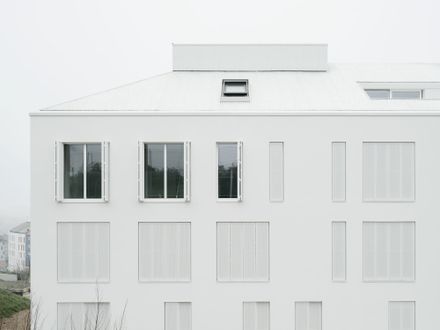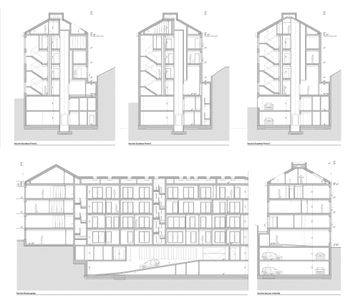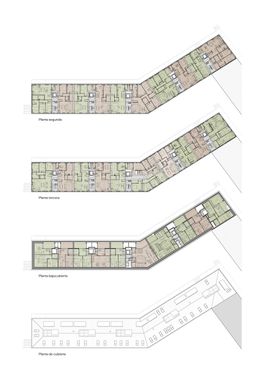Alto Residencial Coop
ARCHITECTS
Carbajo Barrios Arquitectos
TECHNICAL ARCHITECT
Enrique Martínez Carregal
LEAD ARCHITECTS
Manuel Carbajo Capeáns, Celso Barrios Ceide
COLLABORATORS
David Camiño Quintela, Laura Pardo, Beatriz Asore, Alejandro Calviño Pérez
CONSTRUCTION MANAGER
María Blanco Dosil
SIGNAGE DESIGN
Cenlitrometrocadrado
CONSTRUCTION SUPERVISORS
Santiago García, Alberto Vieito, Mario Gerpe
CALCULATION AND DESIGN OF FACILITIES
Obradoiro Enxeñeiros
STRUCTURAL DESIGN
Ameneiros Rey Arquitectos
MARKETING
Juan Alvarez, Fátima Amo, Laura Fernández, Inés González, Samuel Pérez
LOCATION
Santiago De Compostela, Spain
CATEGORY
Apartments
Text description provided by architect.
SCHEDULE
The project foresees the construction of 34 dwellings in an open building promoted by a group of owners constituted as a cooperative, enabling their active participation in formal and programmatic decision-making.
This way of associating reduces construction costs (by eliminating the promoter’s profit), democratises decision-making and generates a sense of belonging for future coexistence and interaction in the built space.
SITUATION
The building sits on one of the last vacant plots of a residential area that, in the 1990s, came about from the development of the area around the Ermita de Santa Marta, next to Monte de Conxo, on the edge of the consolidated urban land of Santiago de Compostela.
In the current urban planning proposed for this area, the residential buildings are developed in open U-shaped blocks embracing interior courtyards for private use, except for the eastern flank of the sector (where this plot is located), which is adapted to the existing low-density building grid, where a series of buildings are planned in open block typology of linear and sinuous form that crowns the highest part of the chosen plot, also serving to resolve the existing slopes, turning the building into an element of containment between different elements of the public space.
PROJECT
The building is volumetrically shaped by taking up the elements that configure the site: a linear element, edge, and limit, materialized as a continuous volume in whose envelope different textures can be recognized:
a perforated sheet metal linked to the openings, which serves as a transition between exterior and interior, and another solid one, with continuous white cladding.
All of this culminates in a sloping roof that reinforces the typological image of the complex and is materialized in accordance with the metallic cladding of the façade openings.
Access to all the dwellings from the street is from a single point, through a large double-height corridor that centralizes all routes, serves as a common vestibule for the five interior communication portals, and leads to the community space situated at the end of the corridor with access to the more secluded public space on the opposite side of the plot.
Designed for a flexible configuration, the openings appear on the façade as elements of interaction between the home and its surroundings.
In addition to the traditional function of lighting and ventilation, a filtering function is added with the exterior superimposition of a perforated sheet metal partition which, allowing light and air to enter, qualifies the relationship between the interior and exterior, generating varying degrees of privacy and establishing a barrier to the incidence of sunlight, with the consequent gradation of the interior temperature of the dwellings at different times of the year.




































